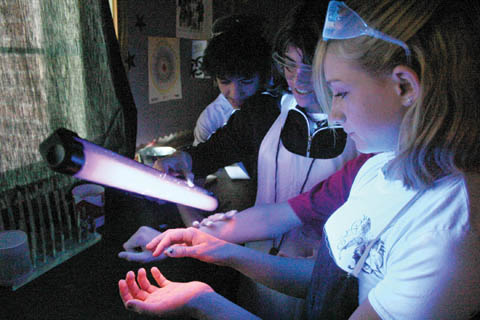| |
|
|

from the issue of April 5, 2007
|

| |
|
|
| |
Summer program expands high school science curricula

Food Science

BY SANDI ALSWAGER KARSTENS, IANR NEWS SERVICE
Nancy Miller, a science teacher at Potter-Dix Public Schools, uses food to teach science.

| | 
 
| | | GLOWING PROGRAM - Potter-Dix Public Schools students work with Glo Germ and a black light. The experiment is part of a UNL summer workshop that uses food to teach science. About 300 Nebraska high school teachers have taken the workshop. Photo by Brett Hampton/IANR News Service.

|
She and about 300 Nebraska high school teachers have taken UNL summer workshops that offer information about the science of foods, such as why milk sours, why potato chips left out in the sun get a bad taste and why an apple turns brown.

Miller incorporated what she learned into her curriculum and now teaches various learning activities that use food.

Miller said she sees students taking away a lot more applicable information and relating what they learn to real life when she teaches science this way.

John Rupnow, a professor in UNL's Department of Food Science and Technology who teaches these workshops, hopes teachers adding this information to their curriculum will attract more students to food science.

Rupnow said there is a great deal of misunderstanding of what a food scientist does.

Graduates of UNL's food science and technology department can find careers with major food processing firms, such as General Mills, ConAgra or Kraft, he said.

Rupnow also uses food to teach science in his Science of Food 131 class. The class, with enrollment of about 700 every semester, teaches basic science principles and basic food principles. He has been teaching it for the last seven years and made it available online three years ago.

"Food is a social part of our lives," he said. "Our religion, family traditions and childhood memories influence what we consider to be a quality food."

Miller, who teaches high school biology and life science and seventh and eighth grade science, said using Rupnow's ideas makes teaching science fun, especially when it can be related to real life.

"Dr. Rupnow was totally awesome," Miller said. "He spreads the word (about food and science) in a fun and professional way."

In one of her classes, Miller uses hamburger to show bacterial growth when under-cooking or not cooking hamburger.

Her class makes four hamburger patties.

One patty is cooked to 120 degrees, another to 140 degrees and a third to 160 degrees. The fourth patty is left raw. The students then swab the hamburger and find out how much more bacteria grows in the under-cooked and raw meat.

"You can really see that heating does kill the microbes," she said.

They also check out the bacterial growth in hamburger left out overnight to thaw in the sink or in the refrigerator. Again, bacterial growth is much more prevalent in the unsafe hamburger left out to thaw in the sink overnight.

"If you don't understand these microbes, it could kill you," she said.

Miller said a lot of her students go home and cook a snack and need to know that any leftovers must be refrigerated promptly.

In addition to food safety, Miller also uses cabbage juice to teach about acids and bases, eggs to see how many teaspoons of salt make them float, celery stalks soaking up colored liquid to discuss plant parts and baking soda and vinegar for chemical reactions.

"It seems I am always buying something at the grocery store," she said.

In addition to food, she also discusses safe hand washing and has her students swab different parts of the school to check for bacteria.

"These experiments make science more fun," she said. "I get a lot of 'oohs' and 'ahs' after the students run around school swabbing things, then get to see the bacteria grow."

She also uses Glo Germ and a black light to allow students to see what germs are lingering under their fingernails or on the back of their hand after not washing them properly.

"This is really teaching real science," she said. "If I don't teach food safety, they could die. They really need to know these food safety issues. It's a life skill."

Rupnow said the UNL program makes an impact on the way food can be worked into science classes.

"As a result of taking our workshops, Nancy was motivated to incorporate this into her curriculum and as a result she received the 2006 National Teacher Award Winner for Agriculture in the Classroom," he said.
GO TO: ISSUE OF APRIL 5
NEWS HEADLINES FOR APRIL 5
Food Science
ITLE lecturer sees success in faculty-driven assessments
Research, creative activity on display
Arts and Sciences dean interviews begin April 12
BIG EVENT
Nebraska Lecture examines challenges of feeding world
Psych symposium to explore smoking, nicotine dependence
Rural Poll to focus on retirement issues
732771S36908X
|
|
|
|
|
|
|
|